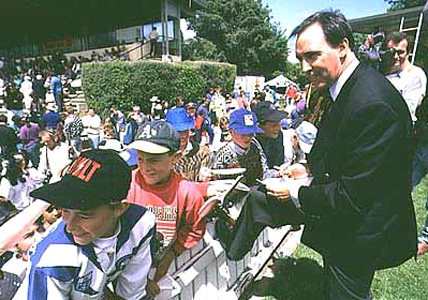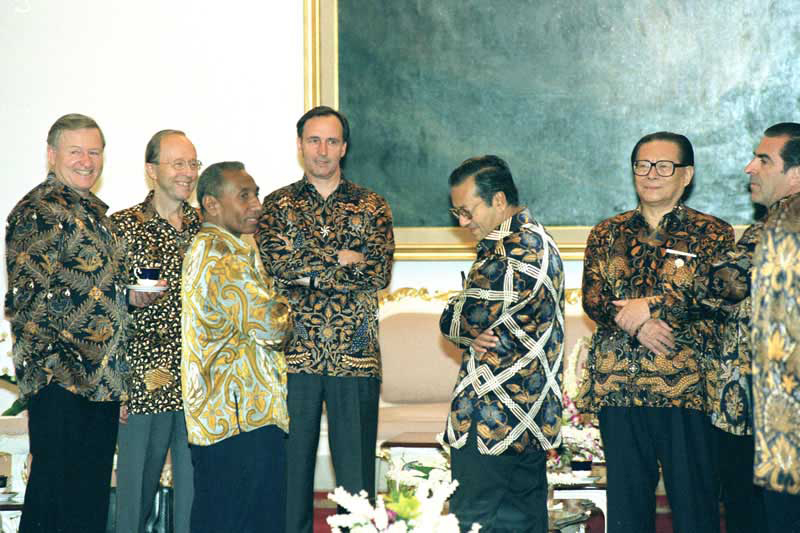Keating, Paul (1944-…), served as prime minister of Australia from 1991 to 1996. As a member of the Australian Labor Party (ALP), Keating took office after 22 years in Parliament and 8 years as federal treasurer. As treasurer and then prime minister, Keating transformed Australia’s banking and financial system. Keating also passed land reforms for Indigenous (native) peoples, initiated the debate on the possibility of an Australian republic, supported education reform, and encouraged economic competitiveness.
Early life and family
Paul John Keating was born on Jan. 18, 1944, in Bankstown, an industrial suburb of Sydney. He was the oldest of four children born to Matthew and Minnie Keating. His father was a boilermaker and union official of Irish descent. 
Keating attended De La Salle College, a Roman Catholic high school in Bankstown. He left early without a diploma in 1959, becoming a pay clerk at Sydney’s electric power authority. Keating soon joined the ALP, developing a close relationship with the radical Labor politician Jack Lang, who had served in the Australian House of Representatives and as premier of New South Wales. In 1964, Keating joined the New South Wales Youth Council (later Young Labor), becoming its president in 1966. Keating also managed a rock band and worked as a researcher and union advocate with the Federated Municipal and Shire Council Employees Union.
On Jan. 17, 1975, Keating married Annita van Iersel (1950-…), a Dutch flight attendant. They settled in the Sydney suburb of Condell Park and had four children, Patrick (1977-…), Caroline (1979-…), Katherine (1982-…), and Alexandra (1985-…). The Keatings separated in 1998.
Political career
Keating won election to Australia’s House of Representatives on Oct. 25, 1969. Entering Parliament at age 25, he was the youngest legislator in the country. He represented the electoral division of Blaxland—covering his hometown of Bankstown and other western suburbs of Sydney—from his election in 1969 until the end of his political career in 1996.
In October 1975, following a shake-up in the ALP administration of Prime Minster Gough Whitlam, Keating served three weeks as minister for northern Australia. At the age of 31, he was one of the youngest ministers in Australian parliamentary history. The governor general, the representative of the British monarch in Australia, removed the ALP government from office on November 11.
After Bob Hawke of the ALP became prime minister on March 11, 1983, Keating—despite limited experience—was appointed federal treasurer. As treasurer, he began the deregulation—that is, the removal of government controls—of Australia’s banking and financial system. He also floated the Australian dollar, allowing free fluctuation of its value.

In April 1990, Keating became deputy prime minister. He became responsible for dealings between Australia’s federal and state governments. On June 3, 1991, with Australia deep in recession (decline in business activity), Keating challenged the leadership of Prime Minister Hawke. However, Keating lost the vote and resigned his ministries. Six months later, he tried again and was successful, becoming prime minister on Dec. 20, 1991.
Prime minister.
In January 1992, one of Keating’s first actions was to establish the Council for Aboriginal Reconciliation to help settle disagreements and improve relations between the Indigenous and non-Indigenous people of Australia. Throughout his administration, Keating took a personal role in securing social justice for Aboriginal and Torres Strait Islander peoples . He presented two major acts of legislation that gave Indigenous peoples access to land: the Native Title Act (1993) and the Land Fund and Indigenous Land Corporation Act (1995).
In 1992, Keating’s government passed two laws involving environmental protection and conservation: the Antarctic Legislative Amendment Act and the Endangered Species Protection Act. That same year, the Disability Discrimination Act outlawed discrimination on the basis of disability. Also in 1992, the Broadcasting Services Act established the Australian Broadcasting Authority, a government agency that regulated broadcasting and telecommunications. Keating promoted closer ties with the Asian region, taking a leading role in the Asia-Pacific Economic Cooperation (APEC) forum.
On March 13, 1993, Keating led the ALP to victory in a general election it was expected to lose. The vote boosted Keating’s government, but his second administration was met with challenges. In 1994, Keating laid out strategies to expand employment and raise workforce skills. In 1995, in an effort to improve utilities, the Australian premiers’ conference, led by Keating, agreed to open state-owned monopolies in electric power, gas, water, and transportation to commercial competition.

During his years as prime minister, Keating advanced the possibility of Australia becoming a republic with an Australian head of state, rather than a constitutional monarchy headed by the British Crown. In 1993, Keating appointed a Republic Advisory Committee to report on the possibility of an Australian republic. Eventually, in 1999, Australian voters rejected the idea.
By the time of the federal election on March 2, 1996, Australians had grown weary of rising foreign debt, high unemployment, and high interest rates on loans. They had also lost confidence in the Keating government’s ability to manage the economy. The ALP lost, conceding power to a coalition of the Liberal and National parties led by John Howard. Howard succeeded Keating as prime minister on March 11, 1996.
Later years
Keating resigned from Parliament on April 23, 1996. Since that time, he has worked on a variety of business interests. He has also served as a visiting professor of public policy at the University of New South Wales. He also wrote Engagement: Australia Faces the Asia-Pacific (2000), which promoted Australian ties to the Asia-Pacific region.
